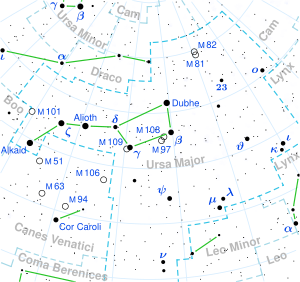Groombridge 1830
| Observation data Epoch J2000 Equinox J2000 |
|
|---|---|
| Constellation | Ursa Major |
| Right ascension | 11h 52m 58.7691s |
| Declination | +37° 43′ 07.239″ |
| Apparent magnitude (V) | 6.44 |
| Characteristics | |
| Spectral type | G8VIp |
| U−B color index | +0.16 |
| B−V color index | +0.75 |
| Variable type | Suspected |
| Astrometry | |
| Radial velocity (Rv) | –98.0 km/s |
| Proper motion (μ) |
RA: 4,003.69 mas/yr Dec.: -5,813.00 mas/yr |
| Parallax (π) | 109.22 ± 0.78mas |
| Distance | 29.9 ± 0.2 ly (9.16 ± 0.07 pc) |
| Absolute magnitude (MV) | 6.62 |
| Details | |
| Mass | 0.661 M☉ |
| Radius | 0.681 ± 0.006 R☉ |
| Luminosity | 0.212 ± 0.002 L☉ |
| Surface gravity (log g) | 4.68 cgs |
| Temperature | 4,759 ± 20 K |
| Metallicity [Fe/H] | –1.33 dex |
| Age | 4.7–5.3 Gyr |
| Other designations | |
| Database references | |
| SIMBAD | data |
Groombridge 1830 (also known as 1830 Groombridge or Argelander's Star) is a star in the constellation Ursa Major.
It is a yellow-hued class G8 subdwarf catalogued by British astronomer Stephen Groombridge with the Groombridge Transit Circle between 1806 and the 1830s and published posthumously in his star catalog, Catalogue of Circumpolar Stars (1838). Its high proper motion was noted by Friedrich Wilhelm Argelander in 1842.
It is 29.9 light-years (9.2 parsecs) from the Sun as measured by the Hipparcos astrometry satellite, which, as the distance is nearly 10 parsecs, means its absolute magnitude is almost equal to its apparent magnitude. It is a member of the galactic halo; such stars account for only 0.1 to 0.2 percent of the stars near the Sun. Like most halo stars, it has a low abundance of elements other than hydrogen and helium—what astronomers term a metal-poor star.
Once suspected of being a binary star with a period of 175 days, current consensus is that it is single. Previous suspected observations of a stellar companion were probably "superflares"—analogous to the Sun's solar flares, but hundreds to millions of times more energetic. It had one of the first nine identified superflares.
When discovered, it had the highest proper motion of any star known, replacing 61 Cygni in that department. Later it dropped to second place after the discovery of Kapteyn's Star, and still later to third place after the discovery of Barnard's Star. It is considerably farther away than either of those stars, however, which means its transverse velocity is greater.
...
Wikipedia


